Most visitors don’t realize the North Rim sits nearly 1,000 feet higher than the South Rim, so it feels cooler and far quieter. You’ll approach through high pinyon and aspen forests, not desert, and find sweeping, less-crowded overlooks like Cape Royal. I’ll show you the best seasons, routes, viewpoints, and practical tips so you can plan a trip that fits your time and stamina—and avoid common mistakes that ruin a visit.
North Rim Vs South Rim: Which Side Is Right for You?
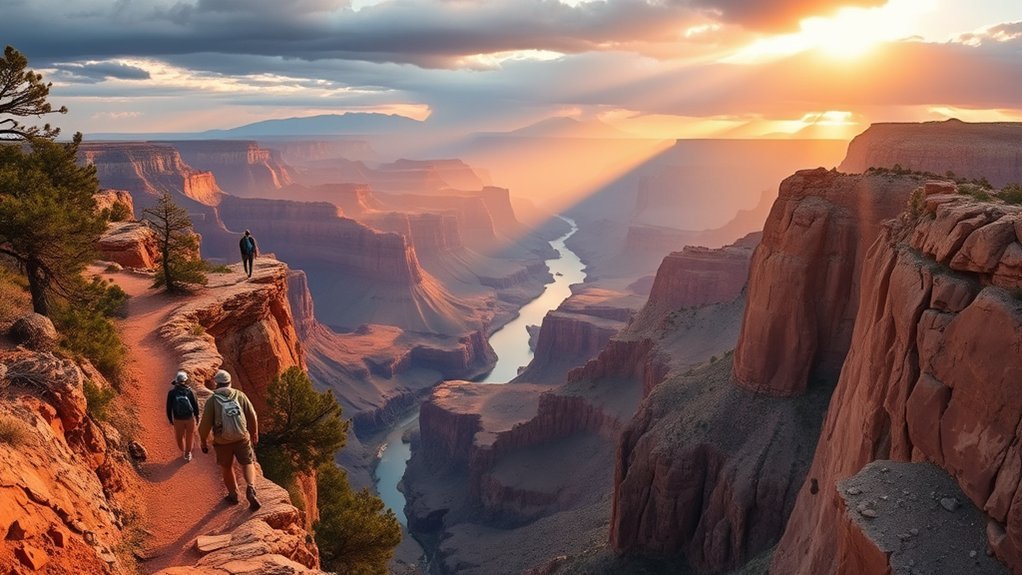
Wondering which rim fits your trip plan? You’ll find the North Rim offers cooler temperatures, dense forests, and a quieter, more secluded experience—only about 10% of park visitors go there—while the South Rim draws over 5 million people with year-round access and iconic vistas. If you crave solitude, the North Rim’s viewpoints like Cape Royal and Point Imperial and its scenic drives give unique perspectives away from crowds. The South Rim, more developed, supplies extensive lodging and dining options and a denser network of hiking trails. The North Rim’s services are limited and more rustic, so you’ll need to plan logistics carefully. Choose based on whether you want solitude and forested overlooks or convenience and famous panoramas.
When to Visit: Seasons, Crowds, and Weather
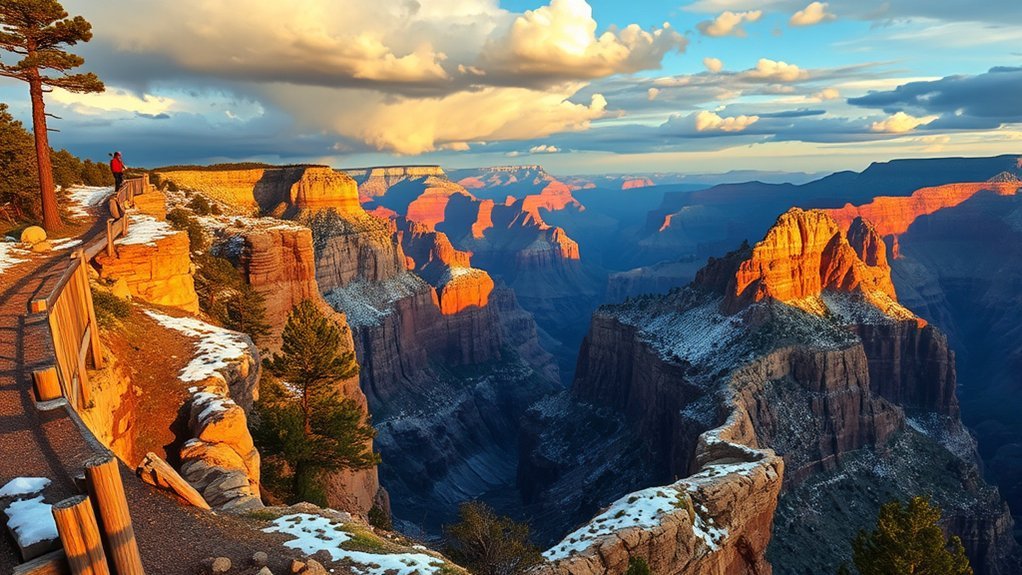
If you want quieter trails and milder temperatures, plan your trip between mid-May and mid-October, with late May–early July and September–October offering the nicest balance of weather and crowd levels. Remember the North Rim sits 5–10°F cooler than the South Rim, so summer days are pleasant but afternoons can still spike toward 90°F while nights may drop near freezing. Also factor in that snow and seasonal road closures from December through mid-May make those months impractical for access.
Best Time to Go
Because the North Rim sits near 8,000 feet, you’ll find cooler, quieter conditions than at the South Rim—summer highs typically reach the mid‑80s°F with nights dipping into the mid‑40s, and the whole area is only open mid‑May through mid‑October, making late May to early July and September to October the sweet spots to visit for pleasant weather and fewer crowds. When planning the best time to go, aim for those shoulder windows to enjoy cooler temperatures, lingering wildflowers, and long light without the crush of visitors. The North Rim is less crowded—about 10% of park traffic—so you’ll savor solitude. Remember weather conditions affect access: roads close for winter and snow can linger near opening and closing, so check forecasts before visiting the North.
Weather and Crowds
While the North Rim’s season is short—mid‑May through mid‑October—you’ll find cooler temperatures, far fewer people, and vivid seasonal shifts that shape when you should go. Visitor access hinges on weather and occasional snow, so plan for shifts in opening dates. Summer highs are about 5–10°F cooler than the South Rim, with crisp nights near 8,000 feet; late May–early July and September–October are the best times to visit for milder weather and lighter crowds. The North Rim gets roughly 10% of Grand Canyon visitors, so weekdays bring real solitude. Late September and early October deliver spectacular fall foliage and quieter scenic drives—ideal for photographers and anyone craving calm viewpoints.
- Quiet mornings that feel almost sacred
- Crisp evenings under starry skies
- Golden aspen-lined overlooks
- Empty pullouts begging exploration
- Intimate, unhurried vistas
How to Get There: Driving Routes and Flight Options
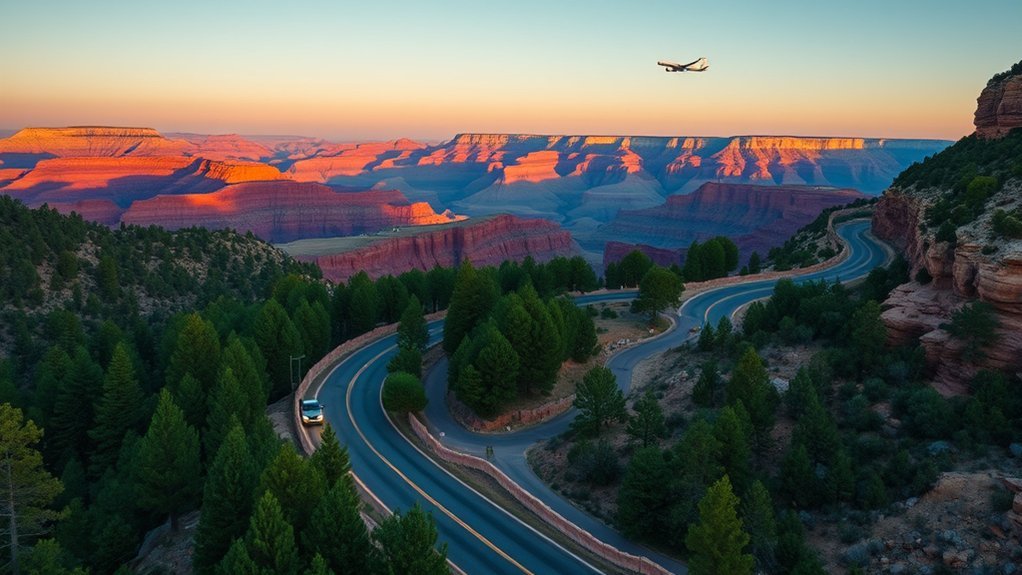
One clear route to the North Rim is Highway 67, a 30-mile drive south from Jacob Lake that becomes a 15-mile stretch from the park entrance to the rim and Grand Canyon Lodge, so plan your timing and fuel accordingly. You’ll also consider driving routes from the South Rim—about 220 miles, roughly 4.5 hours through Utah’s red rock country—if you want a full canyon loop. The closest major airport is Las Vegas (Harry Reid), about 275 miles and a 4.5-hour drive. Note roads often close Dec 1–May 15 because of winter conditions; the North Rim generally opens mid-May and closes mid-October. Monitor weather conditions and high-elevation forecasts before you visit the North.
Park Passes, Permits, and Entrance Tips
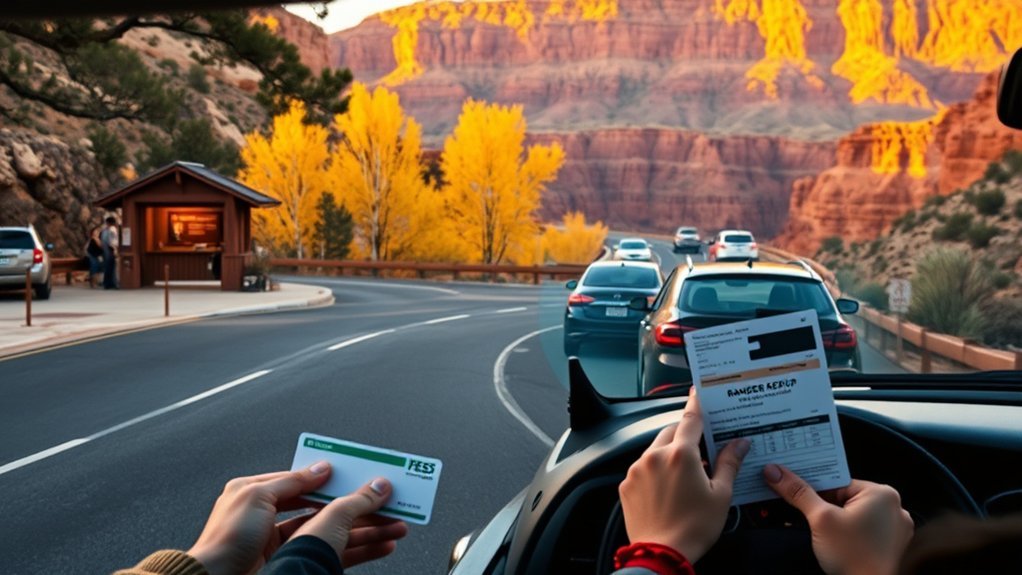
You’ll need a National Park Pass to enter the North Rim—$35 per private vehicle, $30 for motorcycles, and $20 if you arrive on foot, bike, shuttle, or raft. Plan ahead for any special permits, like the $2 Tuweep day pass required in advance, and check permit and safety rules on the NPS site if you’re hiking or camping. Aim to visit between mid‑May and mid‑October but confirm opening dates and weather before you go, and grab a pocket map and services guide at the entrance or visitor center.
Required Park Pass
Because the North Rim sits inside Grand Canyon National Park, you’ll need a valid park pass to enter: $35 per private vehicle, $30 for motorcycles, and $20 for visitors arriving on foot, bike, or shuttle. You should check opening dates and weather conditions before travel; the rim generally opens mid‑May to mid‑October. No advance reservation is required for normal entry, but plan ahead if you’re aiming for Toroweap: a $2 day use permit is required in addition to the National Park Pass. Pick up maps and service guides at the entrance or visitor center to aid planning your visit. Keep permits handy, and respect access rules so all visitors can enjoy the fragile, vast canyon.
- Awe at your first canyon view
- Quiet mornings at the rim
- Relief when logistics fall into place
- Respect for fragile landscapes
- Joy in shared wonder
Special Permits Needed
Although the North Rim feels remote, entry is straightforward if you bring the right passes: a National Park Pass covers most visits (currently $35 per private vehicle, $20 for people on foot or bike), but plan ahead if you want to go to Toroweap (Tuweep) — that spot requires a $2 day‑use permit purchased in advance to limit crowding. Beyond that, you don’t need reservations to drive onto the North Rim during typical access dates (roughly May 15 to late October), though weather-related changes can shift openings. Pick up a pocket map and services guide at the visitor center or download it before you arrive; it helps with special permits, trailheads and logistics. Thoughtful planning your visit keeps your time on Grand Canyon National Park focused on the view.
Entrance Timing Tips
Plan your arrival around the park’s seasonal rhythms: the North Rim is typically open from mid‑May to mid‑October, the Visitor Center runs only during that window, and winter snow can close the road from December through mid‑May. You’ll need a National Park Pass to enter Grand Canyon National Park (fees vary by vehicle or person). Check current weather conditions before you go—storms can alter open dates and road access. You don’t need reservations to drive into the North Rim, but if you’re heading to Tuweep you must buy the $2 Tuweep day pass in advance. Use the visitor center when it’s open for maps and guidance, and plan buffer time for delays or sudden closures.
- Awe at first light breaking the rim
- Quiet pathways after a snowstorm
- Relief at finding a spot to park
- Joy in unexpected weather clearing
- Gratitude for a helpful ranger
Where to Stay: In-Park Lodging and Nearby Accommodations
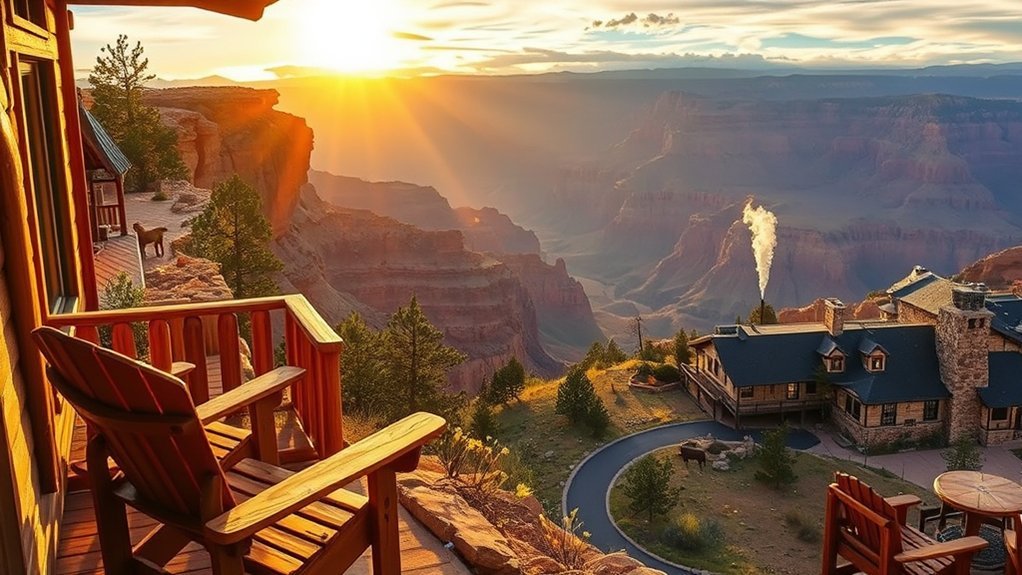
When you decide to stay at the North Rim, your choices range from the rustic comfort of the Grand Canyon Lodge and its cabins to nearby motels and inns that keep you close to the rim; reservations are essential, since lodge rooms and the 87-site North Rim Campground (open May 15–Oct 15) often book far in advance. Choose in-park lodging for sunrise steps from the rim — cabins or main lodge rooms feel timeless, but plan ahead. The North Rim Campground offers quiet tent and RV sites for $18 per night; reserve early. Just outside, Kaibab Lodge sits six miles from the entrance with log cabins and on-site dining, while Jacob Lake Inn (45 minutes away) provides rooms, cabins, dining and fuel. Kanab, Utah, adds more accommodations for longer stays.
Scenic Drives and Must-See Viewpoints
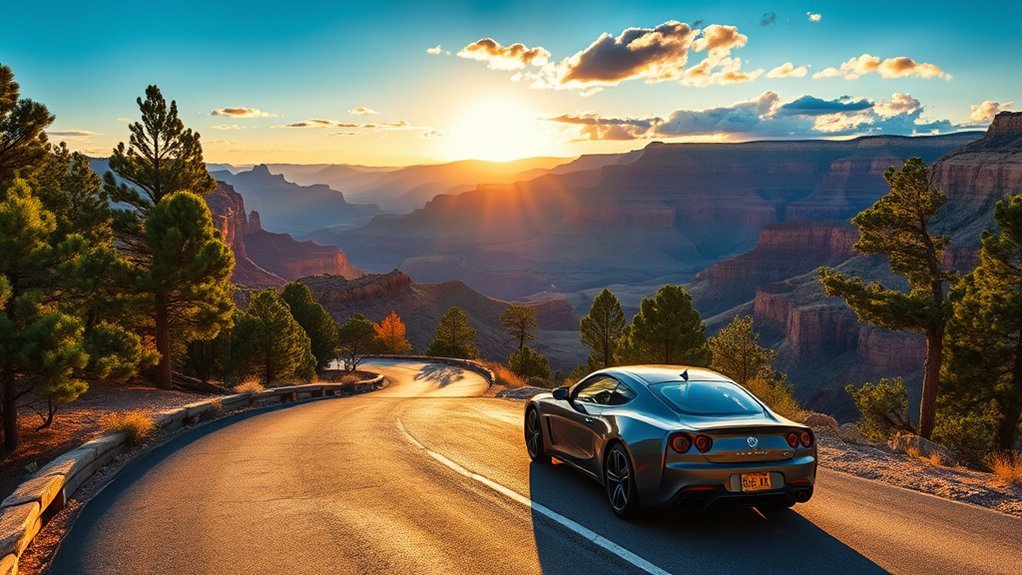
After you’ve settled in—whether in a cabin, campsite, or nearby inn—the North Rim’s scenic drives invite you to explore its highest and most dramatic viewpoints. Drive the 23-mile Cape Royal Road to reach Cape Royal and Angels Window, where expansive views make photography irresistible. Stop at Point Imperial, the park’s highest overlook, for Painted Desert panoramas. Walk the 0.5-mile paved Bright Angel Point trail for sunrise or sunset light. Consider Toroweap (Tuweep) for a vertiginous Colorado River drop, but plan permits and access carefully. Cooler temperatures and lush forests along the route enhance wildlife viewing and the sense of solitude.
- Feel the hush of Ponderosa pine as you round a bend
- Watch light carve the canyon at dawn
- Spot mule deer near the road
- Frame the river in golden hour photographs
- Stand stunned at sheer, timeless cliffs
Best Hikes, Mule Rides, and Guided Activities
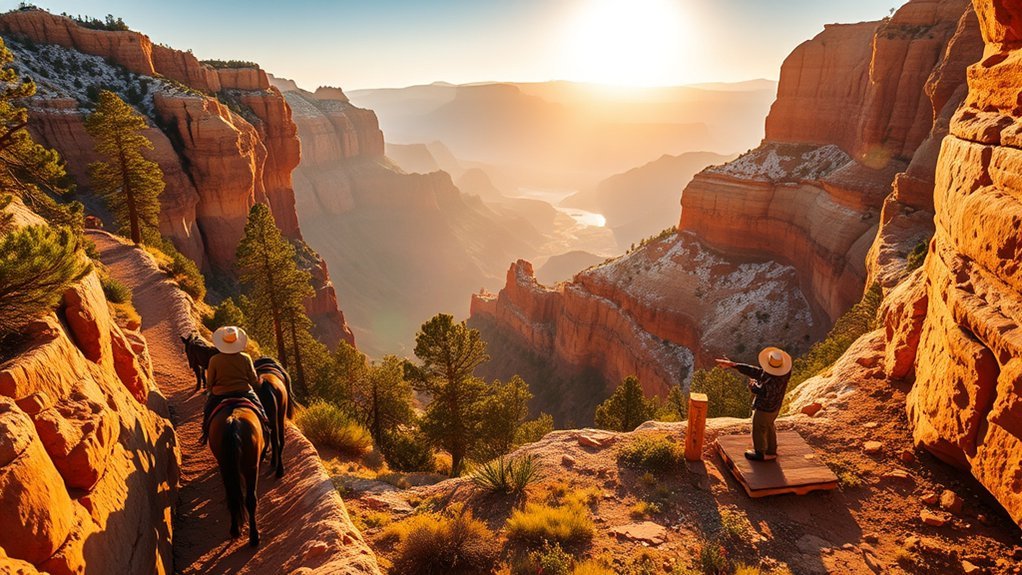
If you’re ready to trade scenic drives for trails and guided experiences, the North Rim delivers—from short, paved overlooks to full-day backcountry challenges and narrated mule rides that connect you to the canyon’s history. Start with the Bright Angel Point Trail for an easy 0.5-mile walk to dramatic North Rim views and nearby scenic overlooks. For a moderate outing, tackle the Cape Final Trail’s 4-mile round trip to see Vishnu and Jupiter Temples. The Widforss Trail rewards you with 9.6 miles of forested solitude opening to expansive canyon panoramas. Serious hikers can descend on the North Kaibab Trail—day hikes to Roaring Springs or multi-day trips to the river. Book Canyon Rides mule rides (1–3 hours) or other guided activities to learn geology and cultural stories from experienced guides.
Photography Tips: Sunrise, Sunset, and Hidden Vistas
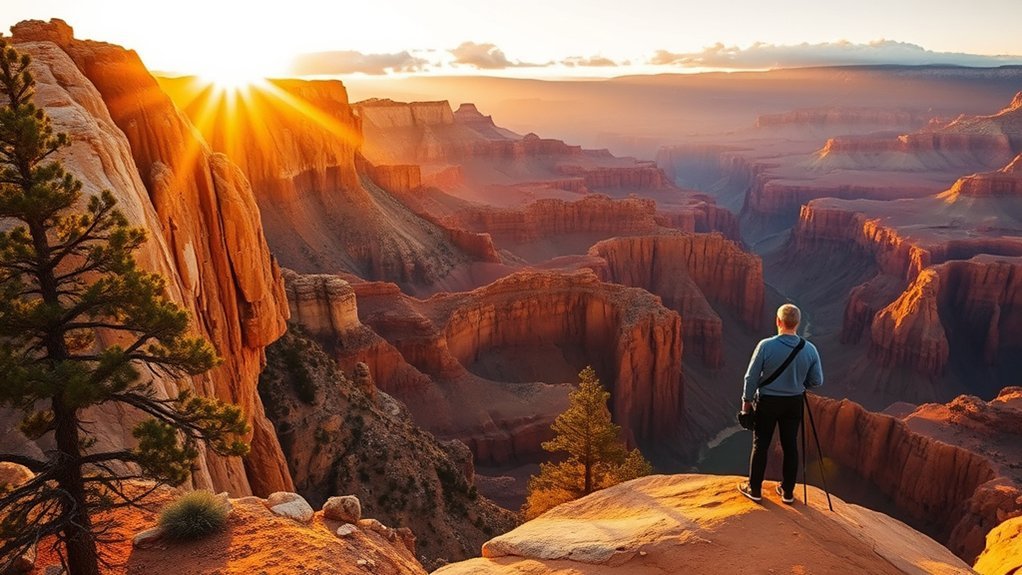
Although the light changes fast, you can still stake out prime compositions by planning your arrival—Bright Angel Point rewards a short pre-dawn walk for sunrise, while Cape Royal and Point Imperial repay a night drive with striking sunset tones; lesser-known spots like Toroweap offer dramatic, low-angle vistas but need extra planning and permits. You’ll want to move before dawn for early morning light, scout viewpoints for layered silhouettes, and adjust exposures as colors shift. Bring warm layers and a headlamp, and expect changing crowds at popular overlooks. Balance wide-angle shots of the canyon’s scale with intimate frames of rock textures and shadow play to capture the park’s mood.
Stake prime viewpoints early—sunrise at Bright Angel, sunset at Cape Royal, or secluded Toroweap for dramatic light.
- Feel the hush of sunrise over stone.
- Chase the molten glow of sunset.
- Seek quiet, hidden vistas.
- Revel in dramatic vistas.
- Honor careful planning and patience.
Safety, Accessibility, and Practical Visitor Advice
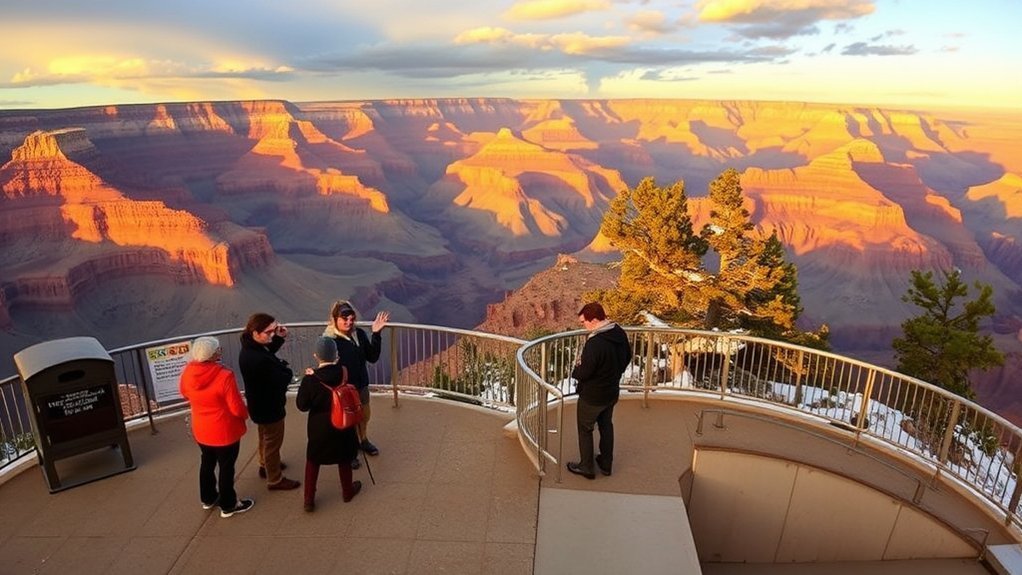
Because the North Rim sits at about 8,000 feet and is reached only by the paved North Rim Parkway from Jacob Lake, you’ll want to plan logistics carefully—fuel up in Jacob Lake (30 miles from the entrance), check weather and road conditions (winter closures commonly run Dec 1–mid‑May), and carry layers for hot afternoons and near‑freezing nights. For accessibility, note limited services and shorter open season; a National Park Pass or entry fee is required. For safety, watch wildlife at dawn and dusk—deer and bison often cross the road—and drive slowly. Monitor weather updates, pack extra water for hydration, and dress for shifting temperatures. Stick to trails and railings at scenic viewpoints, follow park rules, and leave no trace.
Frequently Asked Questions
How Much Time Do You Need to See the Grand Canyon North Rim?
You need about a day for North Rim highlights; two days if you’ll tackle major Hiking Trails. Time Allocation should include Visitor Center, Photography Spots, Wildlife Watching, Campground Facilities, Accessibility Options and Sunset Experiences for Scenic Views.
How to See the Grand Canyon North Rim?
Like a slow breath, you’ll explore North Rim Attractions: visit Scenic Viewpoints, hike Hiking Trails, spot Wildlife Sightings, learn Photography Tips at the Visitor Center, choose Camping Options or Guided Tours, check Road Conditions and admire Local Flora.
Is It Worth Seeing the North Rim of the Grand Canyon?
Yes — you’ll find the North Rim unforgettable: scenic views, photography spots, hiking trails, wildlife sightings, camping options, stargazing opportunities, a visitor center, guided tours, and rich historical significance that rewards curious, observant travelers.
When to Visit Grand Canyon North Rim?
Visit in late May to early July or September–October; those best months balance weather considerations, lower peak season crowd levels, abundant wildlife activity, dramatic photography opportunities, great hiking trails, seasonal events, stunning sunrise views and ideal sunset timings.
Conclusion
Plan for space, plan for time, plan for wonder: arrive prepared, stay flexible, soak in views. Choose the North Rim for quiet, cooler trails and rim-to-river perspective; choose the South Rim for services, sunsets, and access. Watch the weather, respect the trails, carry water, and leave no trace. Travel in season, travel with maps, travel with curiosity. Return rested, return inspired, return with stories that keep the canyon alive in you.

